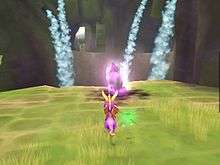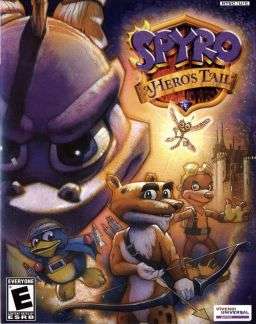Spyro: A Hero's Tail
| Spyro: A Hero's Tail | |
|---|---|
|
The game's cover art, illustrated by movie poster artist Drew Struzan | |
| Developer(s) | Traveller's Tales |
| Publisher(s) | |
| Director(s) | Jon Williams |
| Producer(s) | Suzanne Watson |
| Writer(s) |
Phil Bennet Terry Lloyd |
| Composer(s) |
Steve Duckworth Paul Lawler |
| Series | Spyro |
| Platform(s) |
PlayStation 2 Xbox GameCube |
| Release date(s) | |
| Genre(s) | Platform |
| Mode(s) | Single-player |
Spyro: A Hero's Tail is the fifth console game in the original Spyro series and the ninth game in the series in all. Developed by Eurocom, it was the first game in the series for the Xbox, as well as the second game in the series for the PlayStation 2 and GameCube (with the former console release being the only one of the three to support widescreen). It is also the final installment in the original Spyro continuity for home consoles. This is also the first and only Spyro game to be completely produced in Europe.
The game introduces a new antagonist, Red, a former Dragon Elder banished years before the events of the game, and sees the protagonist, Spyro the Dragon, attempt to defeat him with the aid of his best friend Sparx the dragonfly, Hunter the Cheetah, Sgt. Byrd the flying penguin, and Blink the mole, who are all playable.
Gameplay
The gameplay in A Hero's Tail is largely the same as in previous Spyro games, but with various tweaks to Spyro's abilities and the game's controller mapping, and less of an emphasis on gems; they now act strictly as the game's currency, and are no longer important to completing the game with 20%. There is also a considerable amount of backtracking in the game, with important items only reachable with certain abilities acquired later in the game; some items also require a certain number of light gems to be acquired.

Spyro begins A Hero's Tail with most of his standard abilities including gliding and fire-breath. Spyro's gliding mechanics have been tweaked from previous titles, with the addition of a double-jump and ability to hover downwards by releasing the analog stick. Similar to previous titles, Spyro also acquires multiple breath types to use throughout the game, including electricity, water, and ice; each element has different characteristics and uses throughout the game—for example, electricity can defeat metal-armored enemies, and water is used primarily to solve puzzles. In addition to these elements, Spyro also acquires a projectile-like "secondary breath" attack with each element, which can defeat most enemies, but the player can only store a limited quantity of secondary-breath attacks. Spyro also gains the ability to jump off of walls and swing from poles, similar to other platforming game series such as Prince of Persia and Jak and Daxter, allowing him to traverse obstacles and reach new segments in a level. Also, Sparx, Spyro's dragonfly companion, returns as a personification of Spyro's current health level, and assists in collecting nearby items for the player.
As well as Spyro, four other characters are playable. Sparx, other than helping Spyro, is also playable in his own rail shooter-style minigames. Blink, an anthropomorphic mole, explores levels set in underground mines and caverns, where the player is tasked to locate and destroy various dark shards with explosives. Sgt Byrd, first introduced in Spyro: Year of the Dragon plays host to several flying-themed minigames in which the player is given a set amount of time to locate and fly through (or destroy) various targets and enemies in a level. Hunter, first introduced in Spyro 2: Ripto's Rage!, has two standalone portions of the game to himself. He's able to scale certain walls and attack and snipe enemies using his bow and arrows.
Characters
As well as the returning playable characters, numerous other characters return as well. The Professor appears for his first console appearance since Spyro: Year of the Dragon. Moneybags also returns, but is no longer the upperclass salesman of past games, and is now a merchant with an Eastern European accent. Gnasty Gnorc also makes his first appearance in a Spyro game since the original. The game also introduces Ineptune, an evil sea queen, who alongside Gnasty is working with the game's main antagonist Red - a fallen Dragon Elder who is using Dark Gems in a plot for revenge. Sgt. James Byrd also returns from Spyro: Year of the Dragon. A new character Blink the Mole, makes his first appearance in the game and added to the Spyro series and he's known as the professor's nephew. Also appearing are the Dragon Elders, a group of older dragons who govern the Dragon Realms and teach Spyro new abilities such as the Horn Dive, Pole Spin, Wing Shield and Wall Kick abilities. The four Dragon Elders are Tomas, Magnus, Titan and Astor (named after four dragons that were in the first game). Red was also a former Dragon Elder before his exile.
Synopsis
It has been a long period of peace in the Dragon Realms since Spyro's last adventure. Suddenly, a mysterious dragon named Red is using a group of life-draining stones called the Dark Gems to poison the life of the world. Not only that, he is enlisting Gnasty Gnorc from the first game and his army of Gnorcs to do his dirty work. After freeing a Dragon Elder, Spyro destroys all the Dark Gems in his realm, and Spyro earned Dragon Eggs and Light Gems, and defeats Gnasty Gnorc. Eventually with the aid of the Professor, Spyro makes it the Lost Cities realm, destroying all Dark Gems there and defeating Ineptune, a powerful mermaid-like being. Making it to the Icy Wilderness realm, he is attacked and captured by a mammoth working for Red, but Hunter and Sparx, working together, free him, and Spyro defeats Red in their first battle. Red escapes to the Volcanic Isle, where Spyro and the Professor follow him. After entering Red's laboratory underneath the volcano, Spyro discovers that the Professor has been captured and forced to turn Red's Gnorc army into robots to make them stronger. After accidentally turning Red into a robot called Mecha Red with the Professor's machinery, and after the Professor accidentally increases Red's size, Spyro battles Red and defeats him. The Professor then shrinks Red down to a smaller size, implying that he'll use Red for his experiments.
Getting 100% completion unlocks a hidden alternate ending in which the dragon elders are sitting around the television looking at the game's credits, to which Elder Titan then turns it off.
Voice actors
Besides Michael Gough reprising his role as Gnasty Gnorc and André Sogliuzzo reprising his role as Sparx, none of the other original cast from the previous Spyro games returned to voice any of their characters in this sequel for unknown reasons (e.g. Tom Kenny is replaced by Jess Harnell as Spyro).
- Jess Harnell as Spyro the Dragon, Hunter the Cheetah, Moneybags the Bear, Sgt. Byrd the Penguin, Red, Astor, Magnus, Titan, Tomas, Sparx's speaking voice, Additional Voices
- Tara Strong as Ember the Dragon, Blink the Mole, Zoe the Fairy, Flame the Dragon, and Additional Voices
- Michael Gough as Gnasty Gnorc and The Professor the Mole
- Susanne Blakeslee as Ineptune
- André Sogliuzzo as Sparx the Dragonfly
- Anndi McAfee as Lily the Mermaid, Fairies, and Additional Voices
- Phil Crowley as Otto the Otter
- Fred Tatasciore as Bentley the Yeti, Wally the Walrus, and Additional Voices
- Drew Markham as The Mammoth
- Brad Abrell as Mergatroid the Robot and Phil the Penguin
Reception
| Reception | ||||||||
|---|---|---|---|---|---|---|---|---|
| ||||||||
Aggregating review websites GameRankings and Metacritic gave the PlayStation 2 version 64.59% and 60/100,[1][6] the Xbox version 63.95% and 64/100[2][4] and the GameCube version 63.29% and 62/100.[3][5]
Since its release, Spyro: A Hero's Tail has received mixed to positive reviews from critics, with various saying the game was an improvement over the previous title, Spyro: Enter the Dragonfly.
IGN gave the game a 7 out of 10, saying in a positive review, "Spyro: A Hero's Tail delivers a decent amount of fun. While lacking innovation in style and play mechanics, the game controls well and offers enough challenge and length to warrant a hard look by parents looking to buy a game for their kids. Also, the inclusion of new characters, new attacks and a ton of collectibles will keep collector-nuts playing for at least 15 hours. In the end, A Hero’s Tail is a definite improvement over Enter the Dragonfly. It’s a solid, albeit simple and slightly unimaginative platformer."
GameSpot's review was mixed. Giving it a 5.8 out of 10, they said, "Although Spyro's production values have shot up, its gameplay has remained more or less the same since the series' 1998 debut. Back then, players lacking Nintendo 64s didn't have too many good 3D platformers to choose from, so Spyro's gameplay foibles were acceptable, in light of its uniqueness. The novelty has worn off. Today, modest improvements on this tired formula, like giving Spryo's once-vestigial, T-rex-like arms the ability to grip ledges, just aren't enough to make the game feel innovative. Filling the title with disruptive and boring minigames to artificially increase play time apparently wasn't a good move, either. Despite all the new window dressing, Spyro: A Hero's Tail is the same game you played six years ago, and you probably remember it being better."
References
- 1 2 "Spyro: A Hero's Tail for PlayStation 2". GameRankings. Retrieved 2 October 2013.
- 1 2 "Spyro: A Hero's Tail for Xbox". GameRankings. Retrieved 2 October 2013.
- 1 2 "Spyro: A Hero's Tail for GameCube". GameRankings. Retrieved 2 October 2013.
- 1 2 "Spyro: A Hero's Tail for Xbox Reviews". Metacritic. Retrieved 2 October 2013.
- 1 2 "Spyro: A Hero's Tail for GameCube Reviews". Metacritic. Retrieved 2 October 2013.
- 1 2 "Spyro: A Hero's Tail for PlayStation 2 Reviews". Metacritic. Retrieved 2 October 2013.
